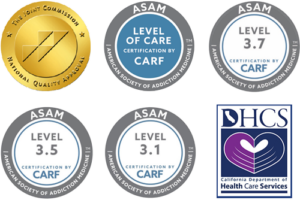Timeline for Alcohol Withdrawal: Onset, Peak, DTs, Seizures & Treatment
Published on: October 23, 2024 | Updated on: December 18, 2025
When someone dependent on alcohol stops drinking, their body and brain begin to recalibrate—often in painful and unpredictable ways. Alcohol has a sedative effect on the nervous system; removing it suddenly causes a rebound surge in excitatory activity. The result is alcohol withdrawal, a process that can range from mild anxiety to life-threatening delirium tremens (DTs).
Understanding when symptoms start, how long they last, and when to seek medical supervision is essential for safety. A medically supervised alcohol detox provides the monitoring, medication, and care needed to prevent seizures and other severe complications.
Understanding the Alcohol Withdrawal Timeline
Withdrawal doesn’t happen in a straight line—it moves through phases as your body adjusts to functioning without alcohol. The timeline reflects both biological recovery and how your nervous system adapts to chemical changes.
Typical course of withdrawal:
- 6–12 hours: Initial symptoms begin (tremor, anxiety, nausea).
- 24–72 hours: Symptoms intensify; this is the high-risk window for seizures.
- 48–96 hours: DTs can emerge, bringing hallucinations, confusion, and extreme agitation.
- 5–7 days: Physical symptoms resolve; mood and sleep issues may persist.
- Weeks–months: Lingering anxiety, low energy, and cravings—known as post-acute withdrawal.
Each person’s timeline varies, but recognizing these patterns helps clinicians plan treatment and family members prepare for what to expect.
For a clinical overview of withdrawal stages, visit MedlinePlus: Alcohol Withdrawal.
6–12 Hours: The Early Onset Phase
The first half-day after the last drink may feel deceptively manageable. During this stage, the nervous system starts firing rapidly, triggering:
- Tremors or shakiness
- Sweating and mild fever
- Restlessness and insomnia
- Headaches, nausea, and loss of appetite
While these signs seem mild, they’re early indicators of physiological dependence. Without monitoring, symptoms can escalate quickly as the body attempts to rebalance. Many people overlook these early warning detox signals, but recognizing them can make the difference between a safe recovery and a medical emergency. Early evaluation by a clinician helps determine if inpatient detox or observation is appropriate.
24–72 Hours: The Peak Phase
The next two to three days are the most unpredictable. The body’s stress hormones surge, heart rate accelerates, and anxiety can become severe. For many people, this period brings:
- Rapid heartbeat and elevated blood pressure
- Profound tremors or shaking
- Severe insomnia and agitation
- Visual, auditory, or tactile hallucinations
- Confusion and disorientation
This window carries the highest risk for withdrawal seizures, which can appear suddenly. Clinicians often use the CIWA-Ar scale to guide treatment intensity and administer benzodiazepines to stabilize the nervous system.
If you or a loved one are approaching this stage, a medical detox program provides continuous supervision and emergency readiness—essential for safety.
6–48 Hours: Seizure Risk Window
Withdrawal seizures typically occur within the first two days of stopping alcohol. A single seizure may be followed by full recovery—or it may signal the onset of more serious complications. These alcohol withdrawal seizures are the result of sudden overactivity in the brain’s electrical system after chronic alcohol use has been abruptly stopped.
Key risk factors include a long history of heavy drinking, previous withdrawal seizures, electrolyte imbalances, and stopping “cold turkey” without medical support. Because seizures can progress to status epilepticus or DTs, immediate evaluation is critical.
Safe detox management at Journey Hillside Tarzana ensures patients receive appropriate medication, monitoring, and IV support to prevent recurrence and protect long-term neurological health.
48–96 Hours: Delirium Tremens (DTs)
DTs are the most dangerous phase of alcohol withdrawal—an acute state of confusion and hyperactivity in the brain. Symptoms include:
- Hallucinations (seeing or feeling things that aren’t there)
- Severe disorientation and agitation
- Fever, sweating, and rapid heartbeat
- Elevated blood pressure or arrhythmias
DTs develop in about 3–5% of people undergoing withdrawal but carry a high risk of complications. Mortality rates drop dramatically with early recognition and inpatient treatment, which is why medical supervision during detox is essential.
For an evidence-based overview of alcohol-related brain changes, see NIAAA: Understanding Alcohol Use Disorder.
5–7 Days: The Acute Withdrawal Resolution
By the end of the first week, most individuals notice a significant improvement in physical symptoms—though exhaustion, anxiety, and sensitivity to stress often persist. Sleep remains fragmented, and appetite slowly returns.
The medical team’s focus shifts from stabilization to nourishment, hydration, and mental health support. At Journey Hillside Tarzana, these steps unfold within a tranquil, therapeutic environment designed for both comfort and safety. Our residential treatment program extends medical detox into recovery-focused therapy for sustainable healing.
Weeks to Months: Post-Acute and Protracted Withdrawal
Recovery continues long after detox ends. The nervous system’s slow recalibration can produce recurring symptoms—collectively called Post-Acute Withdrawal Syndrome (PAWS)—such as:
- Mood swings and low energy
- Insomnia or vivid dreams
- Irritability and craving episodes
- Reduced stress tolerance
While these symptoms can feel discouraging, they’re a sign that the brain is healing. Structured aftercare and counseling—like those in our aftercare program—help clients manage these ups and downs with professional guidance.
Medical Evaluation and Ongoing Monitoring
Every safe detox begins with a full medical evaluation: vitals, labs, nutrition assessment, and a review of co-occurring conditions. In a supervised environment, clinicians track changes in blood pressure, heart rate, electrolytes, and mental status hour by hour.
Continuous monitoring allows rapid adjustment of medications and early intervention if complications appear. This vigilance is what separates a safe detox from a risky home attempt.
Treatment Approaches and Core Goals
The goals of detox are clear:
- Prevent seizures and DTs.
- Correct metabolic and nutritional imbalances.
- Provide comfort and psychological support.
- Transition into comprehensive addiction treatment.
Benzodiazepines remain the first-line therapy for withdrawal stabilization, often supported by thiamine (vitamin B1), hydration, and electrolyte correction. At Journey Hillside, these evidence-based medical withdrawal treatments are complemented by holistic modalities such as yoga, mindfulness, and sound therapy through our clinical programming and experiential therapies.
When to Seek Immediate Medical Help
Certain symptoms should never be managed alone. Seek emergency care right away if you experience:
- Severe confusion or agitation
- Seizures or loss of consciousness
- Persistent vomiting or dehydration
- Fever, rapid pulse, or hallucinations
Timely transfer to a medically equipped setting prevents long-term injury and improves survival rates.
Frequently Asked Questions About Alcohol Withdrawal
Can alcohol withdrawal be fatal?
Yes. Untreated severe withdrawal—especially DTs—can lead to cardiac arrest, seizures, or systemic failure.
How long does it last?
Acute withdrawal typically lasts 5–7 days. Psychological after-effects can linger for weeks or months.
Is home detox safe?
Only under limited circumstances with medical clearance. For most people, supervised detox is far safer.
How do I know if I’m at risk for DTs?
If you’ve had seizures or severe withdrawal before, or drink heavily every day, your risk is elevated.
Begin Detox Safely and Confidently
Stopping alcohol use is a courageous step—but it’s safest with expert care.
Journey Hillside Tarzana offers confidential assessments, medical detox, and personalized residential treatment designed for long-term recovery in a discreet, luxury setting.
- Verify your insurance coverage confidentially.
- Explore what to expect during residential treatment.
Your recovery journey begins with safety, compassion, and a clear medical plan.





